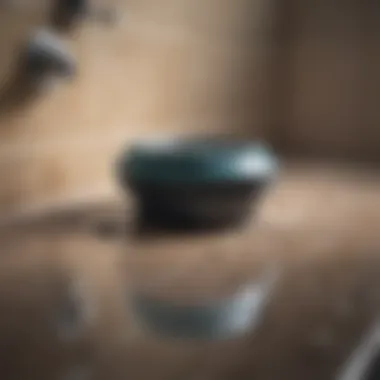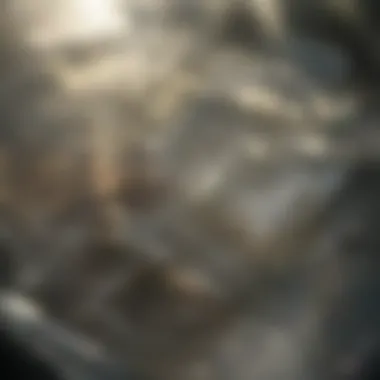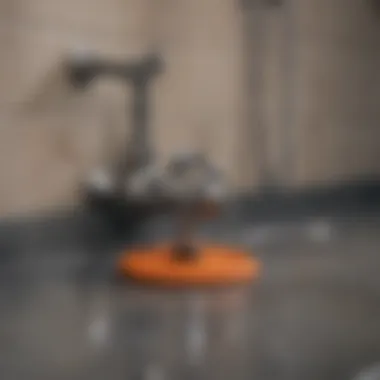Effortless Techniques for Removing Shower Drain Caps


Intro
Removing a shower drain cap may seem like a trivial task, yet it can lead to significant improvements in the functionality of your plumbing system. Understanding how to address this task effectively not only enhances safety but also contributes to the longevity of your fixtures. This guide aims to provide a clear overview of the tools required, the methods to employ, and essential precautions to take.
Feature Spotlight
When it comes to maintaining your shower, particular features must be spotlighted. The drain cap is one such element that plays a pivotal role in the functionality of your plumbing. Effective management of this component can prevent common drainage issues, which may save homeowners from costly repairs down the line.
Exceptional Architectural Designs
In modern bathrooms, the design of shower drains can vary greatly. Some feature intricate patterns while others are simplicity itself. Regardless of the design, it is crucial to retain their functionality. A well-maintained drain ensures that water flows smoothly, reducing the risk of clogs and other plumbing headaches.
Unique Decor Elements
Choosing a decorative drain cap that complements your bathroom decor could also enhance your space. However, personalizing aesthetic elements does not negate the need for functionality. Prioritize a balance between style and usability when selecting or replacing these items.
Tools Required
Before you start to remove a drain cap, you should gather the necessary tools. Having the right items at hand will streamline the process and help prevent damage. Common tools include:
- A flathead screwdriver
- A pair of pliers
- A drain wrench (for stubborn caps)
- A towel or rag for cleanup
Ensure that your tools are in good working order to avoid complications during removal.
Step-by-Step Removal Process
When ready to begin, follow these steps to successfully remove the shower drain cap:
- Assess the Drain Cap: Determine if the cap has screws or if it is simply secured in place by friction.
- Clean the Surrounding Area: Wipe the area around the cap to avoid introducing debris into the drain.
- Use the Screwdriver: If screws are present, use a flathead screwdriver to remove them.
- Apply Pliers if Necessary: If the cap remains stubborn, gently grip it with pliers and twist.
- Utilize a Drain Wrench: For particularly tight caps, a drain wrench can provide the leverage needed to remove it without damaging surrounding materials.
Considerations
Always keep in mind some key considerations during this process:
- User Safety: Wear gloves to protect your hands from sharp edges or chemicals.
- Preventive Measures: Consider installing a strainer to catch debris in the future.
"Regular maintenance of plumbing fixtures can drastically reduce long-term issues and repair costs."
Finale
This guide outlines the fundamental aspects of removing a shower drain cap. While the task may appear insignificant, it is one of many that contribute to an efficient home plumbing system. With the right tools and information, homeowners can manage their plumbing with confidence, ensuring both functionality and aesthetic appeal. By taking preventive measures, there is a chance to extend the life of your fixtures while avoiding unnecessary expenditures.
Prolusion
Removing a shower drain cap may seem like a trivial task at first glance, but it harbors significant importance for homeowners and enthusiasts alike. Understanding how to efficiently handle this task can save time and reduce the likelihood of costly plumbing issues. This article aims to provide a clear and precise guide on the removal of shower drain caps, while ensuring user safety and maintaining the drainage system's integrity.
Understanding the Shower Drain System
The shower drain system is a key component in plumbing, allowing for effective water disposal. Water flows down the drain, passing through a network of pipes that lead to the main sewage system. Cap types and setups can vary widely, depending on the design and age of the installation. Familiarity with these systems is crucial. A well-functioning drain protects against water damage, mold growth, and unpleasant odors.
Prioritizing the maintenance of this system contributes to the overall health of the plumbing in any property.
Importance of Regular Maintenance
Regular maintenance of shower drains cannot be overstated. Over time, hair, soap, and other debris accumulate, leading to blockages. These obstructions can cause water to back up, creating a breeding ground for bacteria and pathogens. Scheduled cleaning can mitigate these risks.
- Benefits of Maintenance:
- Prevents clogging
- Reduces unpleasant odors
- Extends the lifespan of the plumbing system
Taking time to inspect and clean the drain ensures efficient operation and fosters a hygienic environment. This proactive approach can save homeowners from emergencies that arise from neglecting this simple yet essential task.
In summary, understanding and maintaining the shower drain system forms the foundation for effective plumbing solutions.
Identifying the Types of Shower Drain Caps
When it comes to maintaining a shower drain, understanding the types of shower drain caps is crucial. Each type serves its specific purpose and can impact how easily a homeowner can perform repairs or cleaning. Selecting the correct method to access the drain is dependent on recognizing the specific drain cap involved. Knowing the type of cap helps prevent damage during removal, which is essential for maintaining the overall integrity of the drainage system.
Screw-On Caps
Screw-on caps are among the most common variations found in shower drains. These caps feature visible screws that need to be unscrewed to remove the cap. The presence of screws provides a secure seal that protects the drain from debris and unwanted odors escaping.


To identify a screw-on cap, one can simply look for a circular cover with small screw holes along the perimeter. When attempting to remove this type of cap, it is essential to locate and loosen each screw evenly. A screwdriver typically suffices for this task, but care should be taken not to strip the screws, as this might complicate removal further.
Snap-In Caps
Snap-in caps rely on a more straightforward mechanism that involves a series of clips or tabs. These caps do not have visible screws, making them appear more seamless and aesthetically pleasing.
To detach a snap-in cap, it’s important to identify the points of grip where pressure can be applied without causing damage. Applying even pressure around the edges gently can help release the clips. If excessive force is used, it’s possible to break the cap, which can lead to replacement needs.
Lift-and-Turn Caps
Lift-and-turn caps introduce a little more complexity. These caps require twisting and lifting to remove, often incorporating a central mechanism that allows for the lift. These designs can be quite sophisticated and may not be immediately recognizable as caps at first glance.
Understanding how this mechanism works is key to a successful removal. Usually, a simple twist in a designated direction releases the drain cap. Homeowners should take care to ensure that they are turning the cap in the correct direction; otherwise, it may become stuck or cause mechanical failure.
"Identifying the correct type of shower drain cap is essential for effective maintenance and repair. Misidentifying the cap can lead to unnecessary damage and complications."
Essential Tools for the Task
When removing a shower drain cap, having the right tools is critical for success. The importance of these tools cannot be overstated. They not only simplify the removal process but also help prevent damage to the drain and ensure the task can be completed safely. A well-equipped toolkit enables homeowners to tackle the task with confidence and efficiency.
Screwdriver Options
Choosing the correct screwdriver is vital for handling screw-on caps. Different drain caps utilize various types of screws, so having multiple screwdrivers increases the likelihood of successfully removing the cap without damaging it. A standard flathead screwdriver might suffice for some caps, while others require a Phillips-style screwdriver.
It is advisable to have a set of screwdrivers on hand. This ensures that you can match the correct size and type to the screws you encounter:
- Flathead screwdrivers are ideal for older models.
- Phillips screwdrivers fit more modern caps that often have star-shaped screws.
- Precision screwdrivers can help with any small or awkward screws that may be inaccessible with larger tools.
Utilizing the right screwdriver may save time and reduce the risk of slipping, which could lead to injury.
Pliers and Wrenches
Pliers and wrenches are essential when dealing with various drain cap designs, especially for caps that may be tightly secured or corroded. Gripping and turning may require extra force that can only be supplied by these tools. There are specific types to consider:
- Needle-nose pliers can provide precision when maneuvering in tight spaces. They help grip small components without causing damage.
- Adjustable wrenches are perfect for caps that have hexagonal openings, allowing you to apply the necessary torque for removal.
Using pliers or wrenches, be sure to apply pressure gradually to avoid breaking the cap. Excessive force may lead to further complications.
Drain Cleaning Tools
In some cases, cleaning the drain is essential once the cap is removed. Specific tools can facilitate this process:
- Drain snakes can help clear blockages in the drain line after the cap is off.
- Wet-dry vacuums serve to extract debris or water that might hinder the process.
Having these tools ready allows for a comprehensive approach, handling both the removal and potential cleaning tasks in one go. This not only saves time but also helps maintain the integrity of the plumbing systems.
"Proper preparation by using suitable tools can significantly simplify plumbing tasks, enhancing overall effectiveness and safety."
Investing in these essential tools sets the groundwork for a smoother process when dealing with drain caps. Whether you are maintaining your home or taking on a new project, these tools will prove invaluable.
Step-by-Step Guide to Removing Shower Drain Caps
Removing a shower drain cap can seem daunting, but understanding the process step-by-step simplifies the task. This guide focuses on practical methods that allow homeowners and DIY enthusiasts to successfully remove different types of drain caps. By following these steps, one can maintain the overall function and appearance of the shower, preventing potential clogs and drainage issues.
Preparation and Safety
Before diving into the removal process, proper preparation is key. Taking a few safety precautions not only protects the plumbing but also safeguards the individual carrying out the task.
Turning Off Water Supply
Turning off the water supply is the first important step. This action guarantees that no excess water enters the area while you are working. A key characteristic of this step is ensuring that all plumbing repair tasks can be executed without interruption.
It is a beneficial choice because it minimizes the risk of water damage to the floor or any tools you are using. When the water supply is off, you can focus entirely on the task at hand without concern about surprise water flow.
The unique feature of turning off the water supply lies in its simplicity. Moreover, it has the advantage of creating a safer environment, allowing for a more controlled approach to repair tasks.
Using Protective Gear


Using protective gear is another vital aspect. This encourages safe practices, especially when dealing with potential debris and sharp edges around the drain. A common choice includes wearing gloves and safety goggles to shield from dirt and possible injuries.
This precaution is beneficial as it prevents unnecessary cut or exposure to unpleasant substances often found in drains. While protective gear may seem like an extra step, its unique feature is that it cultivates a professional mindset, enabling the task to be done without distraction.
Removing Screw-On Caps
Screw-on caps are among the most common types. Removing them requires specific techniques to ensure success without damage.
Locating Screws
The first task when removing a screw-on cap is locating screws. This is essential as it determines how efficiently the cap can be removed. Identifying the screws, often located around the edges of the cap, is integral.
A significant characteristic is that the type of screws used may vary across products. Familiarity with their position and number will facilitate the process. Locating screws is a beneficial step because if overlooked, it can lead to frustration or damage to both the cap and the drain itself. The advantage of this method lies in its straightforward nature.
Employing a Screwdriver
After finding the screws, employing a screwdriver becomes necessary. This tool provides the force needed to turn the screws and release the cap effectively. A well-fitted screwdriver can make a notable difference in how smoothly the screws loosen.
This choice is beneficial due to the control it offers—users can apply the right amount of torque without excessive force that could cause damage. The unique feature of a screwdriver is its versatility; it can tackle screws of various sizes and types found in different showers.
Detaching Snap-In Caps
Snap-in caps require a different method for removal, often perceived as simple but requiring technique.
Finding Grip Points
Finding grip points on a snap-in cap is critical. These points are usually designed for easier removal and may be located on the edge or side of the cap. Understanding where these grip points are assists in applying correct force without damaging the cap or surrounding areas.
A key characteristic is that using grip points helps in providing leverage, which aids in the overall removal process. This method is beneficial because it prevents slipping, making the task smoother. The advantage is minimal risk of damage compared to other removal methods.
Applying Pressure Evenly
Applying pressure evenly when detaching a snap-in cap is essential. This technique allows the cap to pop out without bending or breaking. It's important to distribute your force uniformly around the cap, enhancing effectiveness.
This choice is beneficial because uneven pressure can lead to frustrating gaps or cracks. The unique feature of this approach is the practicality it offers, ensuring that the removal is clean and straightforward.
Extracting Lift-and-Turn Caps
Lift-and-turn caps add a layer of complexity compared to other types, requiring an understanding of their mechanisms.
Understanding the Mechanism
Understanding the mechanism of lift-and-turn caps is important for effective removal. These caps involve twisting and lifting motions, often combined with a specific sequence. Recognizing this mechanism helps prevent damage to both the cap and the drain.
A key characteristic is the dual motion required—both are necessary to securely remove the cap. This understanding is beneficial as it prepares the individual for the correct method, enhancing the user’s confidence. The advantage is a deeper comprehension of the cap’s design, which aids in manipulation.
Twisting and Lifting
The act of twisting and lifting is the final step in removing a lift-and-turn cap. This requires a gentle yet firm grip to ensure that the cap dislodges correctly without breaking. Applying a consistent motion assists in loosening the cap gradually.
This choice is beneficial because it utilizes a natural movement most users are comfortable with. The unique feature of this method is how it avoids excessive force, presenting a lower risk of damaging the plumbing fixtures.
Troubleshooting Common Issues
Dealing with shower drain caps is often straightforward, but complications can arise. Understanding how to troubleshoot these common issues is essential for maintaining an effective drain system. Problems such as stuck or corroded caps and cap breakage can prevent homeowners from accessing the drainage system. Knowing how to address these issues not only aids in the removal process but also ensures that further damage or unnecessary costs do not occur.
Stuck or Corroded Caps
Utilizing Lubricants
When caps become stuck due to corrosion or other factors, utilizing lubricants can be a key solution. These products help to reduce friction, making it easier to unscrew or detach caps. Common lubricants used include WD-40 or silicone spray. The key characteristic of these lubricants is their ability to penetrate rust and buildup, acting almost like a slippery barrier. This makes them a popular choice for individuals dealing with stuck shower drain caps. The unique feature is that they can oftentimes work within just a few minutes, showcasing their fast-acting properties. However, it is important to note that some lubricants may leave a residue or require additional cleaning later.
Applying Heat Safely
Another effective method for dealing with stuck caps is applying heat safely. This process involves carefully using a heat source, such as a hairdryer or heat gun, to warm the cap. The thermal expansion of the metal can help break the bond causing the cap to stick. One key characteristic of this method is its effectiveness in loosening stubborn fittings. It is a beneficial choice because it often requires no additional chemicals, making it a safer alternative for sensitive plumbing systems. Nonetheless, caution must be taken to avoid damaging surrounding materials or applying excessive heat that could warp the shower fixture.
Cap Breakage


Assessing Damage
In some situations, caps may break during removal. Assessing damage is crucial in determining the next steps. One of the key characteristics in this process is ensuring a thorough examination of the cap and the surrounding area. This helps identify whether further damage has occurred to the drain itself during the removal attempt. This assessment can prevent additional issues in future maintenance work. However, if the damage is extensive, it may require professional repair or replacement, which can be costly.
Replacement Options
When a cap becomes irreparably damaged, understanding the replacement options is important. There are multiple choices for replacing a damaged shower drain cap. Standard options include purchasing locally at a hardware store or looking for specific models online. One beneficial aspect of knowing replacement options is the ability to choose a cap that fits the exact specifications and aesthetics of the shower. This can enhance both functionality and design. However, some caps may require additional installation tools or skills, which some homeowners may lack.
Troubleshooting issues with shower drain caps not only saves time but helps maintain a functional plumbing system.
Alternative Methods of Drain Access
In situations where the traditional removal of a shower drain cap proves challenging, exploring alternative methods becomes crucial. Having options available can save time and effort while addressing common drainage issues effectively. Homeowners and design enthusiasts can benefit from these methods to ensure their plumbing systems function optimally without requiring professional intervention in every instance.
Using alternative methods to access the drain allows for a versatile approach to tackling blockages. It can also minimize potential damage to the drain cap or surrounding fixtures. Utilizing tools like a drain snake or a wet-dry vacuum can enhance both efficiency and effectiveness in clearing obstructions. Employing such tools enables individuals to handle maintenance tasks with more confidence, fostering independence in managing home plumbing.
Using a Drain Snake
A drain snake, also known as a plumber's snake, is an effective tool for addressing clogs in shower drains. This flexible instrument consists of a long, coiled metal wire designed to maneuver through the curves of the plumbing system. To use a drain snake, follow these steps:
- Insert the Snake - Carefully insert the end of the snake into the drain until you encounter resistance.
- Twist and Push - Rotate the handle to allow the snake to grip and dislodge clogs. Apply gentle pressure and continue twisting as necessary.
- Retrieve the Snake - Once the blockage is cleared, slowly pull the snake out, ensuring any debris is removed with it.
A drain snake can effectively remove hair, soap residue, and other debris that commonly accumulate within the drain.
Employing a Wet-Dry Vac
Using a wet-dry vacuum provides an alternative solution for accessing and clearing shower drains. This method is especially useful for removing liquid clogs that a snake might not address. Here’s how to effectively employ a wet-dry vac:
- Create a Seal - Place the vacuum nozzle directly over the drain, ensuring a tight seal to maximize suction.
- Activate the Vacuum - Turn on the wet-dry vac to create a strong suction that can pull liquid and debris from the drain.
- Inspect the Drain - After vacuuming for a few moments, turn off the machine and check if any obstructions remain, repeating as necessary until the drain is clear.
Employing a wet-dry vac not only clears existing clogs but also helps maintain the health of the plumbing system. Regular checks can ensure that systems remain free-flowing, thus reducing the likelihood of future blockages.
By mastering these alternative methods, individuals can maintain their shower drains with greater ease, fostering long-term functionality and reducing the need for professional plumbing assistance.
Preventive Measures for Future Use
Addressing preventive measures regarding shower drain caps is essential for maintaining the efficiency and longevity of your drainage system. Regular actions can prevent future complications, making the process of removing caps easier. Implementing a few simple steps can save time, effort, and potential costs associated with plumbing issues. Staying proactive about maintenance leads to fewer blockages and an overall smoother water flow.
Regular Cleaning Regimen
An effective regular cleaning regimen is crucial for ensuring that your shower drain remains functional. This involves removing hair, soap scum, and other debris that typically accumulate over time. Consider incorporating the following practices into your routine:
- Weekly inspections: Check the drain monthly for any visible blockages.
- Use of drain strainers: These devices minimize debris from entering the pipes. Regularly clean the strainers to remove collected debris.
- Flushing with hot water: Once a month, pour some hot water down the drain to help dissolve any remaining grime.
By establishing this cleaning habit, you can ensure that large clumps of debris do not build up, making it easier to remove the shower drain cap when needed.
Recommended Products for Maintenance
Utilizing specific products enhances the maintenance of your shower drainage system. Here are some recommendations:
- Drain cleaners: Brands like Drano or Bio-Clean can be effective in breaking down clogs. Use them sparingly to avoid harming your pipes.
- Natural cleaning solutions: A blend of baking soda and vinegar can combat buildup without the use of harsh chemicals.
- Pipe brush or drain snake: These tools help you to physically remove blockages that may develop deeper within the drain.
Integrating these products into your maintenance routine will help in prolonging the lifespan of your shower drain while ensuring that removing the cap becomes a less daunting task.
Remember, prevention is always better than cure in plumbing maintenance.
Closure
Understanding how to remove a shower drain cap is crucial for both homeowners and design enthusiasts. This article highlights not only the essential tools and methods for the task but also delves into the maintenance and troubleshooting aspects of shower drain systems.
Summarizing Key Steps
To recap, the process involves several well-defined steps:
- Preparation: Always ensure the water supply is turned off to avoid leaks and water damage.
- Identifying Cap Type: Recognize whether you are dealing with screw-on, snap-in, or lift-and-turn caps, as the removal method varies accordingly.
- Tool Selection: Use appropriate tools like screwdrivers, pliers, or drain cleaning tools to facilitate your work.
- Removing the Cap: Follow the specific approach for your cap type to ensure a safe and effective removal.
- Addressing Issues: Manage common complications such as stuck caps or cap breakage by employing lubricants or assessing damage for replacements.
By following these steps meticulously, homeowners can ensure the integrity of their drainage system while alleviating potential plumbing issues.
Encouragement for Skill Development
Apprenticing in practical home skills, like removing a shower drain cap, empowers homeowners. Engaging in such tasks hones problem-solving abilities and deepens one's understanding of overall home maintenance. Starting with simpler tasks instills confidence, paving the way for tackling more complex plumbing or repair jobs.
Resources like online tutorials and community forums can provide additional insights. Actively participating in DIY projects nurtures skills that are invaluable in home care and improvement.







